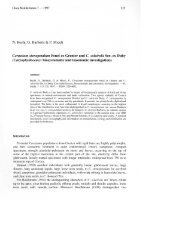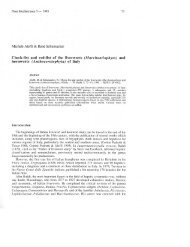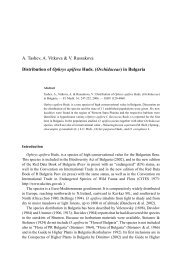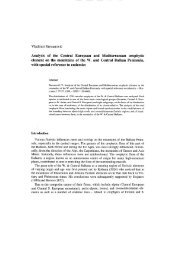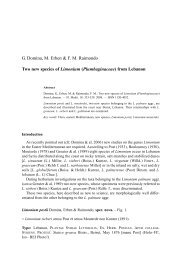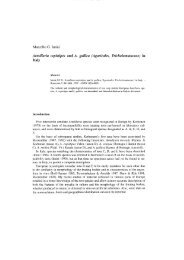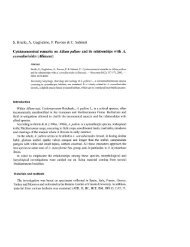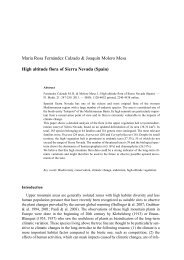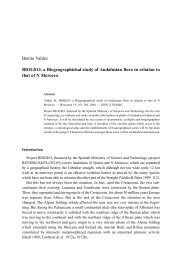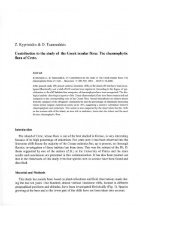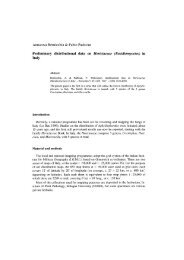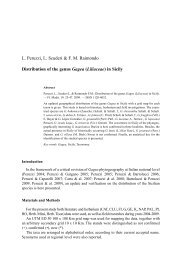Christoph Oberprieler The Systematics of Anthemis L. - Herbmedit.org
Christoph Oberprieler The Systematics of Anthemis L. - Herbmedit.org
Christoph Oberprieler The Systematics of Anthemis L. - Herbmedit.org
You also want an ePaper? Increase the reach of your titles
YUMPU automatically turns print PDFs into web optimized ePapers that Google loves.
16 <strong>Oberprieler</strong>: <strong>Anthemis</strong> in N Africa<br />
A. kruegeriana, A. cyrenaica, and A. taubertii in E Libya, and A. retusa in N Egypt, while<br />
A. rigida is found in the Aegean archipelago.<br />
<strong>Anthemis</strong> sect. Maruta consists <strong>of</strong> 14 species and, according to Meusel & Jager (1992),<br />
inhabits an E Mediterranean-SW Iranian area with one species (A. cotula, incl.<br />
A. lithuanica) being archeophytically distributed throughout Europe and SW Asia. Two<br />
representatives <strong>of</strong> the section, A. cotula and A. pseudocotula, reach N Africa, the former is<br />
presumably introduced by Man into N Morocco (Tangier peninsula, Rif mountains,<br />
Melilla peninsula) and the vicinity <strong>of</strong> cities like Oran (Algeria), Sfax, and Gabès (Tunisia),<br />
the latter reaching the SW Iimit <strong>of</strong> its natural distribution in Cyrenaica.<br />
<strong>Anthemis</strong> subg. Cota, like sect. <strong>Anthemis</strong> and sect. Hiorthia, shows a concentration <strong>of</strong><br />
its species in the SE European and SW Asian part <strong>of</strong> its distributional range. Most <strong>of</strong> its<br />
species are restricted to small areas in the submediterranean parts <strong>of</strong> Turkey and the adjacent<br />
Caucasus countries. However, some perennial members <strong>of</strong> A. sect. Anthemaria (e.g.<br />
A. tinctoria, A. triumfetti), along with monocarpic representatives <strong>of</strong> A. sect. Cota<br />
(A. altissima, A. austriaca), penetrate C and SW Europe. Since A. austriaca is known to<br />
occur synanthropically in ruderal plant cornrnunities <strong>of</strong> C Europe, its occurrence in N<br />
Africa, which is demonstrated in the present paper for the first time, is Iikely due to human<br />
activity.<br />
7. Modes <strong>of</strong> speciation within <strong>Anthemis</strong> in N Africa<br />
<strong>The</strong> N African representatives <strong>of</strong> the genus <strong>Anthemis</strong> <strong>of</strong>fer an interesting insight into the<br />
evolutionary patterns realised in this genus. Most <strong>of</strong> the observed mechanisms also occur<br />
in groups <strong>of</strong> related taxa in other parts <strong>of</strong> the generic range, and in other genera <strong>of</strong> Anthemideae.<br />
As Ehrendorfer (1970) has pointed out, main changes <strong>of</strong> evolutionary patterns<br />
and strategies in this tribe are observed in connection with the switch from perennial to<br />
annuallife formo<br />
New data on N African taxa, along with published records by Uitz (1970), Ehrendorfer<br />
(1970), Mitsuoka & Ehrendorfer (1972), and Kuzmanov & al. (1981), show that <strong>Anthemis</strong><br />
sect. Hiorthia is the only section <strong>of</strong> the genus where polyploidy has played a significant<br />
evolutionary role. Ali <strong>of</strong> the N African representatives <strong>of</strong> this section were found to exist<br />
at the tetraploid level. While A. abylaea, A. eretica subsp. columnae, and A. punctata are<br />
restricted to this level, in the widespread A. pedunculata, and according to pollen dimensions<br />
in some N African populations <strong>of</strong> A. maritima (in A. maritima subsp. bolosii) as<br />
well, diploids are found. <strong>The</strong>se populations, along with the discoid A. alpestris which is<br />
endemic to the Iberian Peninsula, are the only diploid representatives <strong>of</strong> the section in the<br />
W Mediterranean area.<br />
While in <strong>Anthemis</strong> maritima morphological differences between (presumably) diploid<br />
and tetraploid representatives were found to be marked enough to recognise the two entities<br />
as separate subspecies, there seems to exist but little correlation between ploidy level<br />
and morphology in A. pedunculata. Multivariate statistical analyses <strong>of</strong> morphological<br />
variation along with results <strong>of</strong> molecular studies (see chapter 13) indicate that most <strong>of</strong> the<br />
tetraploids have to be considered to be <strong>of</strong> autotetraploidorigin. Though the difference in<br />
ploidy leve I may act as a rather effective crossing barrier, most <strong>of</strong> the tetraploid popula-



